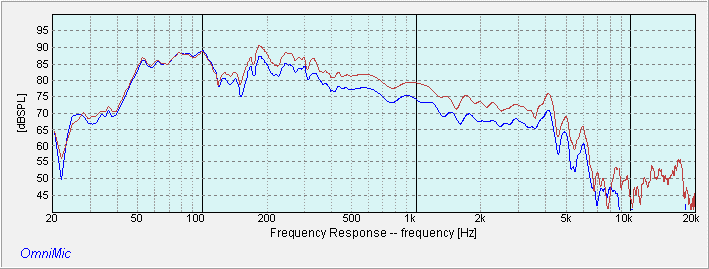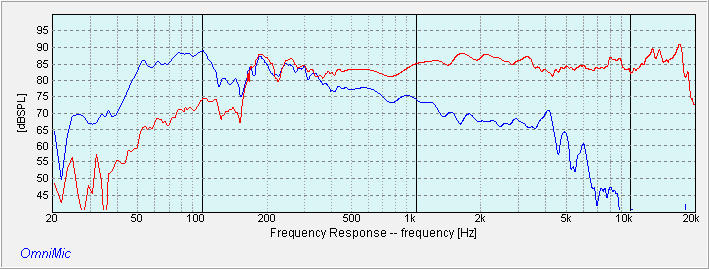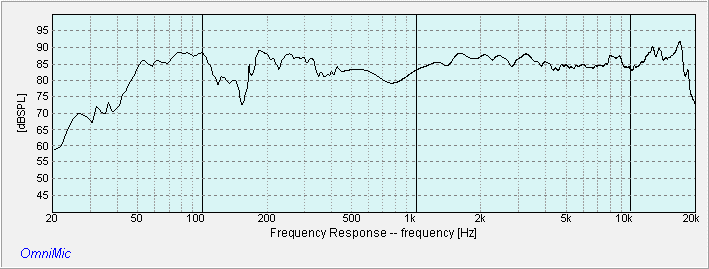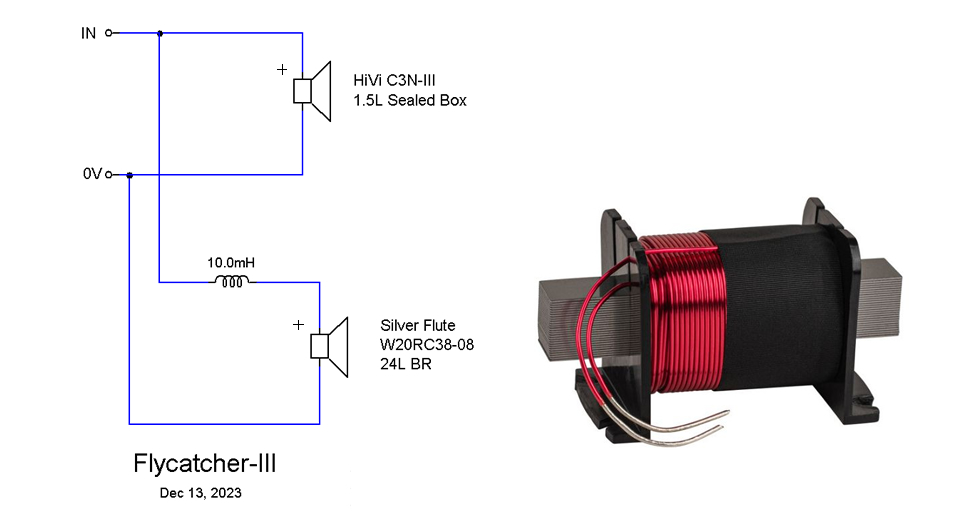|
While the Flycatcher-II is great for vocals, the bass may not be loud enough for some listeners. This is particularly true when in a 4pi placement. To get louder bass, I can either pad down the C3N-III, which I really dislike doing, or to resort to a passive biamp configuration. That is using one power amplifier for the C3N-III and another for the GF180-4. In this arrangement, I can use a potentiometer to reduce the volume of the C3N-III. While this is perfectly feasible, it does increase the cost because another power amplifier is needed. A more elegant solution is to upgrade the 6-1/2″ Dayton GF180-4 to an 8″ Silver Flute. As long as the bass loudness matches the midrange, the tonal balance will be perfect. With this change, it is important to use only one inductor to roll-off the woofer. It is this minimalist philosophy that sets the Flycatcher-III apart from the rest.
The Brown plot above is the Silver Flute W20RC38-08 with a 5.6mH that I used for the GF180-4 in the Flycatcher-II. After listening to it, the vocals didn’t sound quite right. I replaced the 5.6mH with a 10.0mH and the bass and vocals snapped into place (Blue plot).
Fig 2 shows the 8″ Silver Flute in a 24 liters Bass Reflex using a single 10mH inductor and the HiVi C3N-III in a 1.5 liters sealed box. From these plots, it is apparent the bass (100Hz~50Hz) is at the same level of the upper mids (2kHz).
Fig 3 is the summed response of the 8″ Silver Flute with the HiVi C3N-III. The bass loudness from the W20RC38-08 is perfect. No adjustments are necessary.
The simplicity of the Flycatcher-III is in Fig 4. All that’s needed is a 10.0mH, 18AWG iron core inductor. The one I use cost only $16.49 from Part Express. Sound of Flycatcher-III With this simplicity, one may question whether the sound quality is compromised. Actually, the Flycatcher-III sounds better than most speakers. This is mainly because there are no delays introduced with higher order crossovers. Such a design can only be achieved by using a full-range driver and finding a suitable woofer to go with it. During auditioning, I played some tracks with bass. In Donna Summer’s Stop, Look and Listen, the bass did not come out mushy. In fact, there’s some texture in the bass extension. To test how low the bass is, I played If You Leave Me Now (Peter Cetera). The bass came out correct, not truncated like with smaller woofers. And for something nostalgic, a 1972 hit by the Chi-Lites – Oh Girl. The opening has a bass track that identifies the song. The bass is clear enough and doesn’t sound bloated. Flycatcher-III vs Flycatcher-II Having lived with the Flycatcher-III for a few days, my vote goes to the Flycatcher-II. Though the bass is louder with an 8″ woofer, the Flycatcher-III doesn’t have the magic that is in the Flycatcher-II. The speed and dynamics are nowhere close. I would recommend the Flycatcher-II for serious listeners. The Flycatcher-III, on the other hand, is more suited for the general public. Unless otherwise stated, all measurements were made in Full Space (4pi). Mic at 36 ins, tweeter axis. Impulse Window=5ms. No smoothing applied. |

December 15, 2023HIFI DRIVERS, Projects

 Fig 2 – SF W20RC38 with HiVi C3N-III
Fig 2 – SF W20RC38 with HiVi C3N-III Fig 3 – Flycatcher-III Frequency Response
Fig 3 – Flycatcher-III Frequency Response Fig 4 – Flycatcher-III Crossover
Fig 4 – Flycatcher-III Crossover